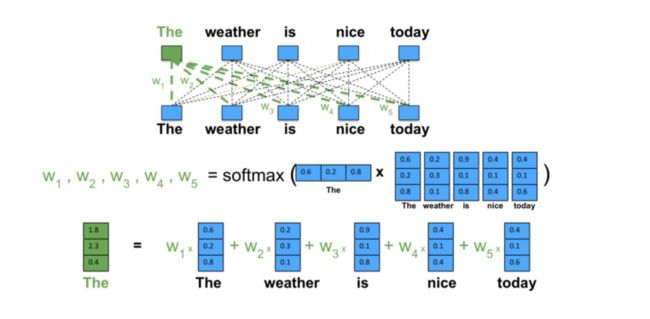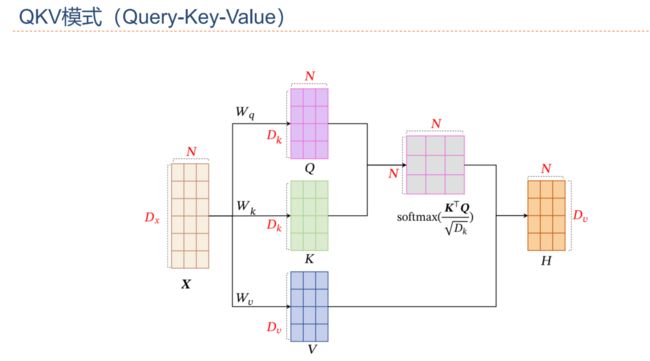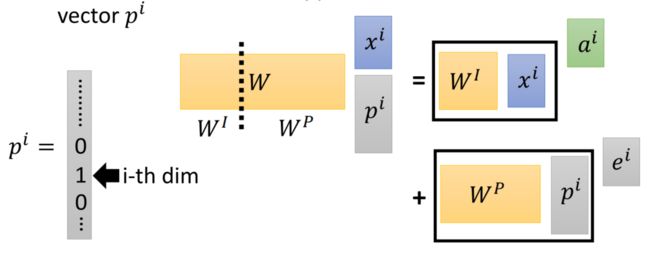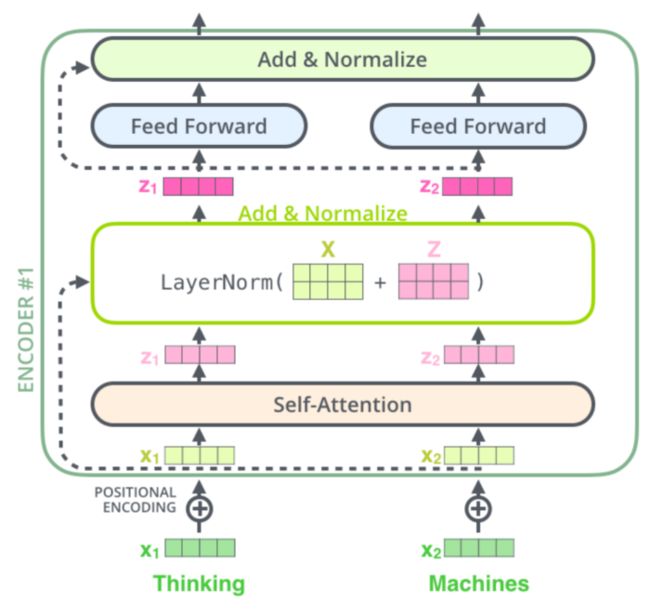注意力&Transformer
注意力
注意力分为两步:
- 其实就是,打分函数进行打分,然后softmax进行归一化
- 根据 α \alpha α来计算输入信息的加权平均(软注意力)
- 其选择的信息是
所有输入向量在注意力下的分布
- 其选择的信息是
键值对注意力
各种注意力的定义
与其只使用单独一个注意力汇聚, 我们可以用独立学习得到的h组不同的 线性投影(linear projections)来变换查询、键和值。然后,这h组变换后的查询、键和值将并行地送到注意力汇聚中。 最后,将这h个注意力汇聚的输出拼接在一起, 并且通过另一个可以学习的线性投影进行变换, 以产生最终输出。这称为多头注意力。
- 对于h个注意力汇聚输出,每一个注意力汇聚都被称作一个头(head)。
自注意力:在深度学习中,经常使用卷积神经网络(CNN)或循环神经网络(RNN)对序列进行编码。
有了注意力机制之后,我们将词元序列输入注意力池化中, 以便同一组词元同时充当查询、键和值。 具体来说,每个查询都会关注所有的键-值对并生成一个注意力输出。 由于查询、键和值来自同一组输入,因此被称为 自注意力(self-attention)
位置编码:
- 在处理词元序列时,循环神经网络是逐个的重复地处理词元的, 而自注意力则因为并行计算而放弃了顺序操作。
- 为了使用序列的顺序信息,通过在输入表示中添加 位置编码(positional encoding)来注入绝对的或相对的位置信息。
- 位置编码可以通过学习得到也可以直接固定得到。
在位置嵌入矩阵P中, 行代表词元在序列中的位置,列代表位置编码的不同维度。
- Layer Normalization
- 残差连接
- Masked mutil-head attetion
- mask 表示掩码,它对某些值进行掩盖,使其在参数更新时不产生效果。Transformer 模型里面涉及两种 mask,分别是 padding mask 和 sequence mask。
- 其中,padding mask 在所 有的 scaled dot-product attention 里面都需要用到
- sequence mask 只有在 decoder的 self-attention 里面用到,sequence mask 是为了使得 decoder 不能看见未来的信息。
Transformer
- 细节详解
克服的问题:
- RNNs的序列模型,串行编码具有天然的顺序属性,但是不能并行
- CNN可以并行,但是是局部连接,且无顺序属性
- 解决:用CNN去代替RNN,让CNN有重合部分达到连续的效果
self-attendtion
Demo to understand
Transformer Encoder
Code
class PositionalEncoding(nn.Module):
"""
compute sinusoid encoding.
"""
def __init__(self, d_model, max_len, device):
"""
constructor of sinusoid encoding class
:param d_model: dimension of model
:param max_len: max sequence length
:param device: hardware device setting
"""
super(PositionalEncoding, self).__init__()
# same size with input matrix (for adding with input matrix)
self.encoding = torch.zeros(max_len, d_model, device=device)
self.encoding.requires_grad = False # we don't need to compute gradient
pos = torch.arange(0, max_len, device=device)
pos = pos.float().unsqueeze(dim=1)
# 1D => 2D unsqueeze to represent word's position
_2i = torch.arange(0, d_model, step=2, device=device).float()
# 'i' means index of d_model (e.g. embedding size = 50, 'i' = [0,50])
# "step=2" means 'i' multiplied with two (same with 2 * i)
self.encoding[:, 0::2] = torch.sin(pos / (10000 ** (_2i / d_model)))
self.encoding[:, 1::2] = torch.cos(pos / (10000 ** (_2i / d_model)))
# compute positional encoding to consider positional information of words
def forward(self, x):
# self.encoding
# [max_len = 512, d_model = 512]
batch_size, seq_len = x.size()
# [batch_size = 128, seq_len = 30]
return self.encoding[:seq_len, :]
# [seq_len = 30, d_model = 512]
# it will add with tok_emb : [128, 30, 512]
class MultiHeadAttention(nn.Module):
def __init__(self, d_model, n_head):
super(MultiHeadAttention, self).__init__()
self.n_head = n_head
self.attention = ScaleDotProductAttention()
self.w_q = nn.Linear(d_model, d_model)
self.w_k = nn.Linear(d_model, d_model)
self.w_v = nn.Linear(d_model, d_model)
self.w_concat = nn.Linear(d_model, d_model)
def forward(self, q, k, v, mask=None):
# 1. dot product with weight matrices
q, k, v = self.w_q(q), self.w_k(k), self.w_v(v)
# 2. split tensor by number of heads
q, k, v = self.split(q), self.split(k), self.split(v)
# 3. do scale dot product to compute similarity
out, attention = self.attention(q, k, v, mask=mask)
# 4. concat and pass to linear layer
out = self.concat(out)
out = self.w_concat(out)
# 5. visualize attention map
# TODO : we should implement visualization
return out
def split(self, tensor):
"""
split tensor by number of head
:param tensor: [batch_size, length, d_model]
:return: [batch_size, head, length, d_tensor]
"""
batch_size, length, d_model = tensor.size()
d_tensor = d_model // self.n_head
tensor = tensor.view(batch_size, length, self.n_head, d_tensor).transpose(1, 2)
# it is similar with group convolution (split by number of heads)
return tensor
def concat(self, tensor):
"""
inverse function of self.split(tensor : torch.Tensor)
:param tensor: [batch_size, head, length, d_tensor]
:return: [batch_size, length, d_model]
"""
batch_size, head, length, d_tensor = tensor.size()
d_model = head * d_tensor
tensor = tensor.transpose(1, 2).contiguous().view(batch_size, length, d_model)
return tensor
class ScaleDotProductAttention(nn.Module):
"""
compute scale dot product attention
Query : given sentence that we focused on (decoder)
Key : every sentence to check relationship with Qeury(encoder)
Value : every sentence same with Key (encoder)
"""
def __init__(self):
super(ScaleDotProductAttention, self).__init__()
self.softmax = nn.Softmax(dim=-1)
def forward(self, q, k, v, mask=None, e=1e-12):
# input is 4 dimension tensor
# [batch_size, head, length, d_tensor]
batch_size, head, length, d_tensor = k.size()
# 1. dot product Query with Key^T to compute similarity
k_t = k.transpose(2, 3) # transpose
score = (q @ k_t) / math.sqrt(d_tensor) # scaled dot product
# 2. apply masking (opt)
if mask is not None:
score = score.masked_fill(mask == 0, -10000)
# 3. pass them softmax to make [0, 1] range
score = self.softmax(score)
# 4. multiply with Value
v = score @ v
return v, score
class LayerNorm(nn.Module):
def __init__(self, d_model, eps=1e-12):
super(LayerNorm, self).__init__()
self.gamma = nn.Parameter(torch.ones(d_model))
self.beta = nn.Parameter(torch.zeros(d_model))
self.eps = eps
def forward(self, x):
mean = x.mean(-1, keepdim=True)
var = x.var(-1, unbiased=False, keepdim=True)
# '-1' means last dimension.
out = (x - mean) / torch.sqrt(var + self.eps)
out = self.gamma * out + self.beta
return out
class PositionwiseFeedForward(nn.Module):
def __init__(self, d_model, hidden, drop_prob=0.1):
super(PositionwiseFeedForward, self).__init__()
self.linear1 = nn.Linear(d_model, hidden)
self.linear2 = nn.Linear(hidden, d_model)
self.relu = nn.ReLU()
self.dropout = nn.Dropout(p=drop_prob)
def forward(self, x):
x = self.linear1(x)
x = self.relu(x)
x = self.dropout(x)
x = self.linear2(x)
return x
class EncoderLayer(nn.Module):
def __init__(self, d_model, ffn_hidden, n_head, drop_prob):
super(EncoderLayer, self).__init__()
self.attention = MultiHeadAttention(d_model=d_model, n_head=n_head)
self.norm1 = LayerNorm(d_model=d_model)
self.dropout1 = nn.Dropout(p=drop_prob)
self.ffn = PositionwiseFeedForward(d_model=d_model, hidden=ffn_hidden, drop_prob=drop_prob)
self.norm2 = LayerNorm(d_model=d_model)
self.dropout2 = nn.Dropout(p=drop_prob)
def forward(self, x, src_mask):
# 1. compute self attention
_x = x
x = self.attention(q=x, k=x, v=x, mask=src_mask)
# 2. add and norm
x = self.dropout1(x)
x = self.norm1(x + _x)
# 3. positionwise feed forward network
_x = x
x = self.ffn(x)
# 4. add and norm
x = self.dropout2(x)
x = self.norm2(x + _x)
return x
class Encoder(nn.Module):
def __init__(self, enc_voc_size, max_len, d_model, ffn_hidden, n_head, n_layers, drop_prob, device):
super().__init__()
self.emb = TransformerEmbedding(d_model=d_model,
max_len=max_len,
vocab_size=enc_voc_size,
drop_prob=drop_prob,
device=device)
self.layers = nn.ModuleList([EncoderLayer(d_model=d_model,
ffn_hidden=ffn_hidden,
n_head=n_head,
drop_prob=drop_prob)
for _ in range(n_layers)])
def forward(self, x, src_mask):
x = self.emb(x)
for layer in self.layers:
x = layer(x, src_mask)
return x
class DecoderLayer(nn.Module):
def __init__(self, d_model, ffn_hidden, n_head, drop_prob):
super(DecoderLayer, self).__init__()
self.self_attention = MultiHeadAttention(d_model=d_model, n_head=n_head)
self.norm1 = LayerNorm(d_model=d_model)
self.dropout1 = nn.Dropout(p=drop_prob)
self.enc_dec_attention = MultiHeadAttention(d_model=d_model, n_head=n_head)
self.norm2 = LayerNorm(d_model=d_model)
self.dropout2 = nn.Dropout(p=drop_prob)
self.ffn = PositionwiseFeedForward(d_model=d_model, hidden=ffn_hidden, drop_prob=drop_prob)
self.norm3 = LayerNorm(d_model=d_model)
self.dropout3 = nn.Dropout(p=drop_prob)
def forward(self, dec, enc, trg_mask, src_mask):
# 1. compute self attention
_x = dec
x = self.self_attention(q=dec, k=dec, v=dec, mask=trg_mask)
# 2. add and norm
x = self.dropout1(x)
x = self.norm1(x + _x)
if enc is not None:
# 3. compute encoder - decoder attention
_x = x
x = self.enc_dec_attention(q=x, k=enc, v=enc, mask=src_mask)
# 4. add and norm
x = self.dropout2(x)
x = self.norm2(x + _x)
# 5. positionwise feed forward network
_x = x
x = self.ffn(x)
# 6. add and norm
x = self.dropout3(x)
x = self.norm3(x + _x)
return x
class Decoder(nn.Module):
def __init__(self, dec_voc_size, max_len, d_model, ffn_hidden, n_head, n_layers, drop_prob, device):
super().__init__()
self.emb = TransformerEmbedding(d_model=d_model,
drop_prob=drop_prob,
max_len=max_len,
vocab_size=dec_voc_size,
device=device)
self.layers = nn.ModuleList([DecoderLayer(d_model=d_model,
ffn_hidden=ffn_hidden,
n_head=n_head,
drop_prob=drop_prob)
for _ in range(n_layers)])
self.linear = nn.Linear(d_model, dec_voc_size)
def forward(self, trg, src, trg_mask, src_mask):
trg = self.emb(trg)
for layer in self.layers:
trg = layer(trg, src, trg_mask, src_mask)
# pass to LM head
output = self.linear(trg)
return output
ViT & Swin Transformer
Shifted Window
- 旋转取代滑动
















































